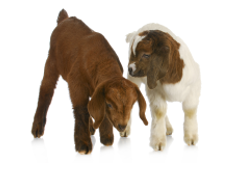Four Tips for Choosing a Kid Goat Milk Replacer
Jan 11, 2023

The right nutrition early in your kid goat’s life can set the stage for their lifetime performance. Choosing the right milk replacer for your kid goats can be a daunting task. Consider these tips to feel confident in choosing what’s best for your goat herd.
1. Consider Which Kids Should Be Fed Milk Replacer.
Feeding milk replacer allows you to market doe’s milk and helps grow big, vigorous kids who can stand out in the showring, parlor or breeding herd. Consider feeding kid milk replacer to:
2. Select a Quality Formulation.
You will want to choose a milk replacer that closely resembles doe’s milk and is specially formulated for goats. While multispecies milk replacers are available, not all of them will properly meet your goat’s nutritional needs.
By choosing a kid-specific milk replacer such as LAND O LAKES® Doe’s Match® Kid Milk Replacer, you can ensure your kids are getting a balance of 25% protein and 28% fat to mimic doe’s milk and provide nutritional value for efficient growth. In fact, research has shown that kids fed LAND O LAKES® Doe’s Match® kid milk replacer a greater average daily gain at 0.43 lb. per day as compared to 0.37 lb. per day to kids that are naturally reared.1
3. Know When to Feed Kid Milk Replacer.
Milk replacer should be fed on day two after feeding colostrum. At the same time, it’s important to provide kids with fresh, clean water along with a free-choice, high-quality dry feed. Start by feeding a half pint of milk replacer mixture three to four times a day for the first three days. Gradually decrease the number of feedings and increase the volume fed per feeding. Feed for at least four to six weeks of age. Adjust feeding rates according to age, bodyweight and growth goals.
4. Choose a Formulation That Mixes Well.
A milk replacer with poor quality ingredients can cause milk replacer to separate during the mixing process, leading to unbalanced nutrition. To get the most out of your milk replacer choose a quality formulation that is tested for consistent mixing and nutrition. Additionally, proper mixing techniques are key. First, start with a water temperature between 110-120°F. Next, weigh your milk replacer powder to ensure accurate mixing. Lastly, once mixed, check the temperature again. It should be 105°F when fed.
-----Purina Animal Nutrition LLC
1. Consider Which Kids Should Be Fed Milk Replacer.
Feeding milk replacer allows you to market doe’s milk and helps grow big, vigorous kids who can stand out in the showring, parlor or breeding herd. Consider feeding kid milk replacer to:
- Dairy goat kids.
- Orphan, unclaimed or extra kids in large litters.
- Weak or small kids.
- Prevent the spread of Caprine Arthritis Encephalitis (CAE) to kids.
2. Select a Quality Formulation.
You will want to choose a milk replacer that closely resembles doe’s milk and is specially formulated for goats. While multispecies milk replacers are available, not all of them will properly meet your goat’s nutritional needs.
By choosing a kid-specific milk replacer such as LAND O LAKES® Doe’s Match® Kid Milk Replacer, you can ensure your kids are getting a balance of 25% protein and 28% fat to mimic doe’s milk and provide nutritional value for efficient growth. In fact, research has shown that kids fed LAND O LAKES® Doe’s Match® kid milk replacer a greater average daily gain at 0.43 lb. per day as compared to 0.37 lb. per day to kids that are naturally reared.1
3. Know When to Feed Kid Milk Replacer.
Milk replacer should be fed on day two after feeding colostrum. At the same time, it’s important to provide kids with fresh, clean water along with a free-choice, high-quality dry feed. Start by feeding a half pint of milk replacer mixture three to four times a day for the first three days. Gradually decrease the number of feedings and increase the volume fed per feeding. Feed for at least four to six weeks of age. Adjust feeding rates according to age, bodyweight and growth goals.
4. Choose a Formulation That Mixes Well.
A milk replacer with poor quality ingredients can cause milk replacer to separate during the mixing process, leading to unbalanced nutrition. To get the most out of your milk replacer choose a quality formulation that is tested for consistent mixing and nutrition. Additionally, proper mixing techniques are key. First, start with a water temperature between 110-120°F. Next, weigh your milk replacer powder to ensure accurate mixing. Lastly, once mixed, check the temperature again. It should be 105°F when fed.
-----Purina Animal Nutrition LLC